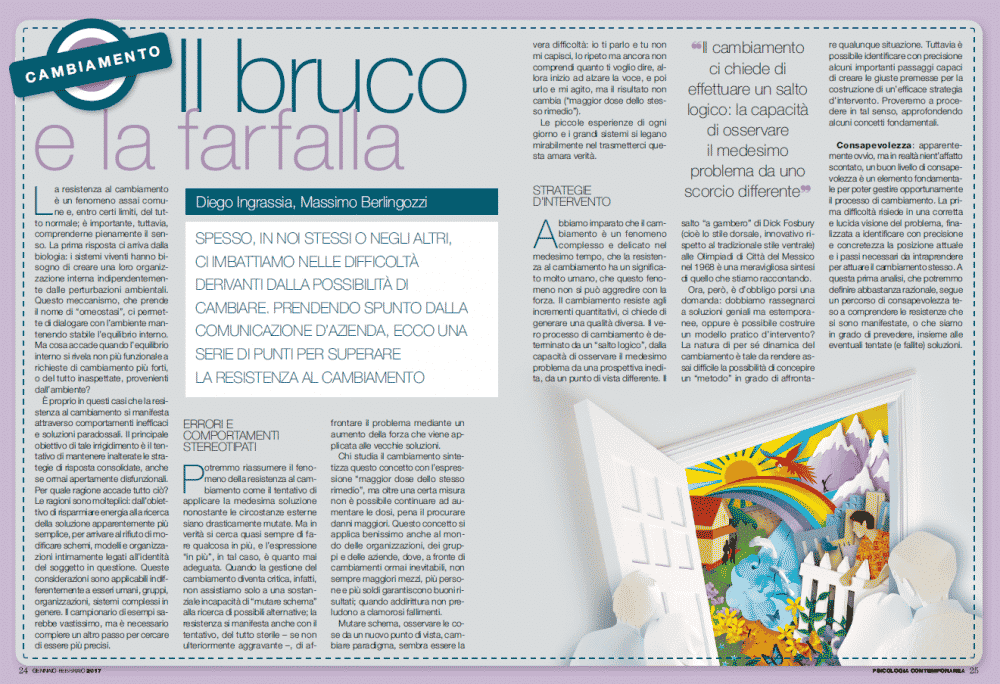
Communicating Motivation
11 July 2017
EMOTIONS IN COUPLES
24 July 2017THE CATERPILLAR AND THE BUTTERFLY

“IL BRUCO E LA FARFALLA” by Diego Ingrassia and Massimo Berlingozzi
for PSICOLOGIA CONTEMPORANEA – Change – n. 259, January-February 2017 – GIUNTI EDITORE
Resistance to change is a very common phenomenon and, within certain limits, completely normal; it is important, however, to fully understand its meaning.
The first answer comes to us from biology: living systems need to create their own internal organisation independently of environmental perturbations.
This mechanism, which is called ‘homeostasis’, allows us to converse with the environment while maintaining a stable internal balance.
But what happens when the internal balance proves to be no longer functional to stronger, or completely unexpected, demands for change from the environment?
It is precisely in these cases that resistance to change manifests itself through ineffective behaviour and paradoxical solutions.
The main objective of such inflexibility is the attempt to maintain established response strategies, even if they are now openly dysfunctional.
Why does this happen? There are many reasons: from the aim of saving energy to the search for the seemingly simplest solution, to the refusal to change patterns, models and organisations intimately linked to the identity of the subject in question.
These considerations are equally applicable to human beings, groups, organisations and complex systems in general. The sampling of examples would be vast, but it is necessary to take another step to try to be more precise.
HERRORS AND STEREOTIPED BEHAVIOUR.
We could summarise the phenomenon of resistance to change as the attempt to apply the same solution despite the fact that external circumstances have changed drastically.
But in truth, one almost always tries to do something more, and the expression ‘more’ in this case is as appropriate as ever.
When change management becomes critical, in fact, we do not only witness a substantial inability to ‘change the pattern’ in search of possible alternatives; resistance also manifests itself in the utterly sterile – if not further aggravating – attempt to deal with the problem by increasing the force that is applied to the old solutions.
Those who study change summarise this concept with the expression ‘higher dose of the same remedy’, but beyond a certain extent, it is not possible to continue to increase doses, on pain of causing greater damage.
This concept also applies very well to the world of organisations, groups and companies, where, in the face of now inevitable changes, more means, more people and more money do not always guarantee good results; when they do not even herald resounding failures.
Changing the scheme, looking at things from a new point of view, changing the paradigm, seems to be the real difficulty: I talk to you and you don’t understand me, I repeat it but you still don’t understand what I want to say, then I start to raise my voice, and then I shout and get upset, but the result doesn’t change (‘more of the same’).
Small everyday experiences and big systems tie in admirably in conveying this bitter truth to us.
STRATEGIES OF INTERVENTION
We have learnt that change is a complex and delicate phenomenon at the same time, that resistance to change has a very human meaning, that this phenomenon cannot be attacked by force.
Change resists quantitative increases, it asks us to generate a different quality.
The true process of change is determined by a ‘logical leap’, by the ability to look at the same problem from a new perspective, from a different point of view.
Dick Fosbury’s ‘shrimp’ jump (i.e. the dorsal style, innovative compared to the traditional ventral style) at the 1968 Mexico City Olympics is a wonderful summary of what we are talking about.
Now, however, a question must be asked: should we resign ourselves to ingenious but extemporary solutions, or is it possible to construct a practical model of intervention? The inherently dynamic nature of change is such that it is very difficult to devise a ‘method’ that can deal with any situation.
However, it is possible to precisely identify a number of important steps capable of creating the right premises for the construction of an effective intervention strategy.
We will try to do so by delving into some fundamental concepts.
Awareness: Seemingly obvious, but in reality not at all taken for granted, a good level of awareness is a fundamental element to be able to properly manage the change process. The first difficulty lies in a correct and lucid vision of the problem, aimed at identifying with precision and concreteness the current position and the necessary steps to be taken to implement the change itself. This first analysis, which could be described as quite rational, is followed by a path of awareness aimed at understanding the resistances that have arisen, or that we can foresee, together with any attempted (and failed) solutions. At this point, it is easy to understand (and experience confirms this further) that some of these steps often make external help indispensable: coach, therapist, counsellor, etc., depending on the different contexts imaginable.
Motivation: A full and sincere motivation is the indispensable fuel for tackling a journey that in some cases can be long and tiring. The mistake most often made in such cases is thinking that one can impose change. Sense, freedom and responsibility are the words that should guide the search for true motivation. Nobody can replace us in building the necessary motivation, which is why it is important that the meaning of our commitment is not imposed on us. Everyone must search for the value and meaning of their actions in full freedom, through a conscious assumption of responsibility.
Bibliographical references .
- .
- LORENZ K., POPPER K. (1985), The future is open (transl. it.), Rusconi, Milano.
- O’SULLIVAN M., EKMAN P. (2004), ‘The wizards of deception detection’. In P. A. Granhag, L. A. Stromwall (Eds.), The detection of deception in forensic contexts, Cambridge University Press, Cambridge.
- WATZLAWICK P. (1989), The tail of Baron Münchhausen. Ovvero: psicoterapia e “realtà” (transl. it.), Feltrinelli, Milan, 1991.
- WATZLAWICK P., WEAKLAND J. H., FISCH R. (1974), Change. On the formation and solution of problems (transl. it.), Astrolabium, Rome.
.
.
.
.



